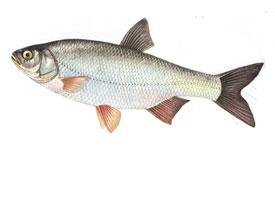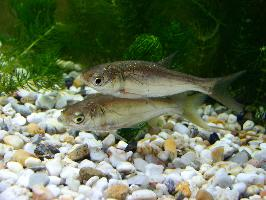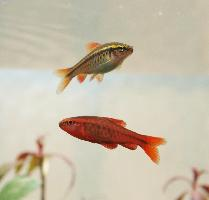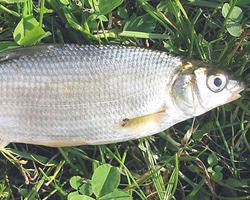
Greutăți și măsuri
| Lungime | 75 cm |
|---|---|
| Greutate | 8 kg |
Date biologice
| Durata de viață | 20 r |
|---|
Descrierea animalului
The Ide, scientifically known as Leuciscus idus, is a captivating freshwater fish that belongs to the Cyprinidae family, which is renowned for its diverse and widespread species. Native to Europe and Asia, the Ide has adapted to a variety of water bodies, ranging from clear streams and rivers to lakes and ponds, showcasing its remarkable adaptability and resilience.Physically, the Ide is a medium to large-sized fish, with adults typically reaching lengths of 30 to 50 cm, although some specimens have been known to grow up to 70 cm in exceptional cases. The body of the Ide is elongated and somewhat cylindrical, tapering towards the tail, which is a common feature among members of the Cyprinidae family. Its scales are large and possess a shiny, metallic sheen, with coloration that varies from silver to golden, and sometimes even displaying a beautiful olive green hue on the back. This vibrant coloration not only makes the Ide a visually appealing species but also serves as camouflage against predators in its natural habitat.
One of the most distinctive features of the Ide is its fins, which are typically red or orange, providing a stark contrast against its body. This coloration is particularly pronounced during the spawning season, making it a spectacular sight in its natural environment. The Ide has a broad, slightly downturned mouth, which is an indication of its omnivorous diet. It feeds on a variety of food sources, including aquatic plants, insects, small crustaceans, and occasionally small fish, demonstrating its opportunistic feeding behavior.
The Ide is known for its remarkable spawning behavior, which typically occurs in the spring as water temperatures begin to rise. During this period, females lay thousands of eggs in shallow, well-oxygenated waters, often among vegetation or on gravel beds, where males then fertilize them. This reproductive strategy ensures a high survival rate for the offspring, contributing to the Ide's sustainability in its natural habitat.
In addition to its natural beauty and interesting behavior, the Ide holds significant cultural and economic value in some regions. It is highly regarded as a sport fish, providing anglers with challenging and rewarding fishing experiences. Furthermore, in some European countries, the Ide is cultivated for food and ornamental purposes, highlighting its versatility and importance to human societies.
Despite its resilience, the Ide faces threats from habitat destruction, pollution, and the introduction of invasive species, which can lead to declines in population in certain areas. Conservation efforts are essential to ensure the survival of this fascinating species, emphasizing the need for sustainable practices to protect and preserve natural water bodies and their inhabitants.
In summary, the Ide (Leuciscus idus) is a remarkable fish that embodies the beauty and diversity of freshwater ecosystems. Its physical attributes, feeding habits, and reproductive behavior make it a subject of interest not only for biologists and conservationists but also for anglers and aquarium enthusiasts. As a symbol of the resilience and adaptability of nature, the Ide serves as a reminder of the importance of preserving our natural world for future generations.
Animale similare
Fotografii noi cu animale
Top 10 animale
- Diana monkey (Cercopithecus diana)
- Dolphin gull (Leucophaeus scoresbii)
- Galápagos tortoise (Geochelone nigra complex)
- Moustached guenon (Cercopithecus cephus)
- Japanese spider crab (Macrocheira kaempferi)
- Colossal squid (Mesonychoteuthis hamiltoni)
- Fox tapeworm (Echinococcus multilocularis)
- Stone loach (Barbatula barbatula)
- Japanese macaque (Macaca fuscata)
- Barbary macaque (Macaca sylvanus)


